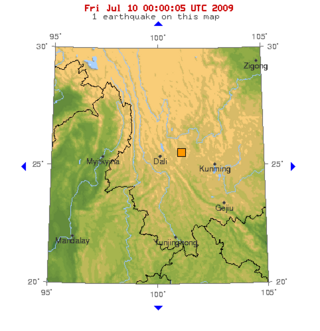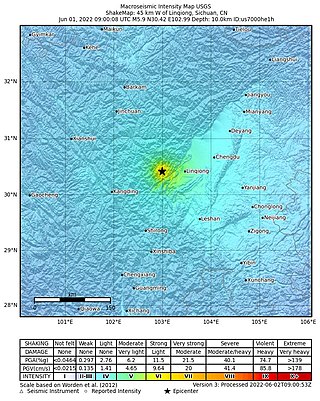
Ruichang is a county-level city under the jurisdiction of Jiujiang, in the north of Jiangxi province, along the Yangtze River, bordering Hubei province to the north.
The 2003 Bachu earthquake occurred on 24 February at 10:03 local time in the Xinjiang Autonomous Region in northwest China. The epicentre was located near to the town of Jiashi and Bachu County, approximately 105 km east of Kashgar and 310 km west of Aksu.

The 2008 Kyrgyzstan earthquake struck on October 5 at 21:52 local time with a moment magnitude of 6.6, killing 75 people, including 41 children, and injuring 150 people, including 93 children. The center of the earthquake was near the town of Nura, which was destroyed in the quake. The shock destroyed dozens of buildings in the area and destroyed the nearby village of Kura. Minor damage also occurred in nearby Xinjiang Uyghur Autonomous Region. The quake was felt throughout Central Asia. A magnitude 5.7 aftershock in Xinjiang and a magnitude 5.1 aftershock in Kyrgyzstan followed the earthquake. Two more aftershocks above magnitude 5 in Kyrgyzstan and one in Xinjiang struck on October 13, UTC time. Victims were transported in military helicopters to hospitals in Osh.
The 1953 Ionian earthquake struck the southern Ionian Islands in Greece on August 12. In mid-August, there were over 113 recorded earthquakes in the region between Kefalonia and Zakynthos, and the most destructive was the August 12 earthquake. The event measured 6.8 on the moment magnitude scale, raised the whole island of Kefalonia by 60 cm (24 in), and caused widespread damage throughout the islands of Kefalonia and Zakynthos. The maximum felt intensity of shaking was X (extreme) on the Mercalli intensity scale. Between 445 and 800 people were killed.

The 2009 Yunnan earthquake occurred with a moment magnitude of 5.7 in Yao'an County, Yunnan province, People's Republic of China on 9 July. At least one person died and over 300 were injured, with over 50 of these sustaining serious injuries.
The 1867 Manhattan earthquake struck Riley County, Kansas, in the United States on April 24, 1867, at 20:22 UTC, or about 14:30 local time. The strongest earthquake to originate in the state, it measured 5.1 on a seismic scale that is based on an isoseismal map or the event's felt area. The earthquake's epicenter was near the town of Manhattan.
The Jiashi earthquakes were a series of earthquakes from 1997 to 2003, with several earthquakes larger than 6 occurring between January and April 1997. Two strong earthquakes with magnitudes Ms 6.4 and 6.3 occurred on January 21, 1997, at 09:47 and 09:48 local time, respectively, in Jiashi County of Xinjiang Autonomous Region, NW China. The earthquakes occurred on a major strike-slip fault beneath the Tarim Basin. The fault has no surface expression and prior to the earthquake was unknown. At least 12 people were killed and 40 injured in the earthquakes of January 21. Another earthquake on March 1, 1997, at 14:04 local time with magnitude Ms 6.0 killed another person. On April 6, 11 and 16, other four earthquakes with magnitudes Ms 6.3, 6.4, 6.6 and 6.3 killed 8 people. Several predictions were made in this earthquake series. Some of the predictions were not fulfilled, while some preceded the predicted earthquake from 2.5 hours to 4 days. The April 11 earthquake occurred 30 minutes after a prediction was made. Rebiya Kadeer wrote that her career was significantly affected by the earthquakes, which were "one of the worst natural disasters that had occurred in the Uyghur nation in recent memory." One hundred villages and one thousand homes were leveled. Kadeer organized donations and aid for the area.
The 2011 Yunnan earthquake was a 5.4 magnitude earthquake that occurred on 10 March 2011 at 12:58 CST, with its epicenter in Yingjiang County, Yunnan, People's Republic of China, near the Burmese border. A total of 26 people died and 313 were injured with 133 in serious condition. China's Xinhua reports that up to seven aftershocks, measuring up to a magnitude of 4.7, followed the initial quake, which caused a total of 127,000 people to be evacuated to nearby shelters. It joined over 1,000 other minor tremors that affected the region in the two preceding months. Following damage surveys, officials reported that 1,039 buildings were destroyed and 4,994 more were seriously damaged. The earthquake occurred one day before a much larger earthquake struck Japan that triggered a tsunami.

The 2014 Ludian earthquake struck Ludian County, Yunnan, China, with a moment magnitude of 6.1 on 3 August. The earthquake killed at least 615 people, injuring at least 2,400 others. At least 114 people remained missing. Over 12,000 houses collapsed and 30,000 were damaged. According to the United States Geological Survey, the earthquake occurred 29 km (18 mi) west-southwest of Zhaotong city at 16:30 local time (08:30 UTC).

A major earthquake occurred in Nepal on 12 May 2015 at 12:50 pm local time with a moment magnitude of 7.3, 18 kilometres (11 mi) southeast of Kodari. The epicenter was on the border of Dolakha and Sindhupalchowk, two districts of Nepal. This earthquake occurred on the same fault as the larger magnitude 7.8 earthquake of 25 April, but further east than the original quake. As such, it is considered to be an aftershock of the April quake. It struck at a depth of 18.5 km (11.5 mi). Shaking was felt in northern parts of India including Bihar, Uttar Pradesh and West Bengal. Tremors were felt as far as about 2,400 km away from the epicenter in Chennai.
The 1979 Bali earthquake occurred at with a surface-wave magnitude of 6.3. The shock occurred southeast of the coast of Karangasem Regency in the Lombok Strait, and about 60 kilometres (37 mi) east-northeast of Denpasar. Up to 80 percent of the buildings in Karangasem Regency were damaged, between 15,000 and 500,000 people were displaced, and road links to the provincial capital of Denpasar were briefly severed.
A magnitude 6.9 earthquake struck Myanmar 135 km (84 mi) north-west of Mandalay on April 13 with a maximum Mercalli intensity of VI (Strong). It struck at 8:25 pm local time, and was centered in an isolated area. The estimated depth was 134 km. It lasted for around one minute according to Xinhua reporters.

At 23:50 (UTC+8) on 6 February 2018, an earthquake of magnitude 6.4 on the moment magnitude scale hit Taiwan. The epicenter was on the coastline near Hualien, which was the most severely affected area, with a maximum felt intensity of VIII (Severe) on the Mercalli intensity scale. At least 17 deaths were reported, with 285 injured. The maximum foreshock was recorded on 4 February 2018, at 21:56:40. The epicenter was located at Hualien County, Taiwan, reaching a scale of ML 5.8.
The 1988 Lancang–Gengma earthquakes, also known as the 11.6 earthquakes by the Chinese media were a pair of devastating seismic events that struck Lancang and Gengma counties, Yunnan, near the border with Shan State, Burma. The earthquake measured moment magnitude (Mw ) 7.0 and was followed 13 minutes later by a 6.9 Mw shock. These earthquakes were assigned a maximum China seismic intensity of IX and X, respectively. Between 748 and 939 people were killed; more than 7,700 were injured. Both earthquakes resulted in US$270 million in damage and economic losses. Moderately large aftershocks continued to rock the region, causing additional casualties and damage.
The 2020 Kashgar earthquake, also known as the Jiashi earthquake occurred on 19 January 2020 at 21:27:56 China Standard Time in Xinjiang Province, China. According to the United States Geological Survey, the earthquake had a moment magnitude of 6.0 and a surface wave magnitude of 6.4 according to the China Earthquake Network Center. It struck at a shallow depth of 5.6 km according to the USGS while the CENC has the figure at 16 km. Local emergency management agencies said the earthquake damaged more than 1,000 homes and businesses in the nearby populated towns and villages. One person is known to have died while two other children were injured.
The 1998 Zhangbei–Shangyi earthquake occurred at 11:50 local time on 10 January with a moment magnitude of 5.7 at a depth of 14.1 km. It struck the province of Hebei in Zhangjiakou. At least 70 people died, 11,500 were injured and a further 44,000 families were homeless in the wake of the event. Damage was reported in the town of Zhangbei, Hebei Province, as well as to sections of the Great Wall of China.
The 1923 Renda earthquake occurred on March 24 at 20:40 local time between the counties of Daofu and Luhuo in Sichuan, China. The estimated 7.3 earthquake was assigned a maximum modified Mercalli intensity scale rating of X (Extreme). Severe damage occurred in Sichuan, killing an estimated 4,800 people.
The 1937 Heze earthquakes struck the Mudan District in Shandong Province, China on July 31 and August 1 respectively. The moment magnitude 7.0 and 6.7 earthquakes were centered near the city of Heze. Although the total number of casualties has never been finalized, at least 3,252 people died and 12,701 were injured. The earthquakes also killed more than 6,000 livestock and destroyed 470,000 homes. Due to the outbreak of the Second Sino-Japanese War, rescue operations by the Chinese government were ineffective.

On June 1, 2022, a moment magnitude (Mw ) 5.8 or surface-wave magnitude (Ms ) 6.1 earthquake struck Lushan County in Ya'an, Sichuan Province, China. At least four people were killed and 42 were injured. The earthquake had a maximum intensity of VIII on the China seismic intensity scale, causing damage to many homes and triggering rockslides.







